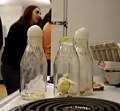 By definition the use of significant figures in measurement and value is a form of rounding. They represent the the number of digits in a number, beginning at the first non-zero digit and including any trailing zeros. For instance, 0.005746180 has 7 significant figures. All 7 of those digits are significant, if someone were measuring a distance, volume, time period or whatever and they included all those numbers as well as that final zero, you would assume that they had measured the value to seven significant figures. The next number after the final digit would not be reliable and so is not included.
By definition the use of significant figures in measurement and value is a form of rounding. They represent the the number of digits in a number, beginning at the first non-zero digit and including any trailing zeros. For instance, 0.005746180 has 7 significant figures. All 7 of those digits are significant, if someone were measuring a distance, volume, time period or whatever and they included all those numbers as well as that final zero, you would assume that they had measured the value to seven significant figures. The next number after the final digit would not be reliable and so is not included.
Understanding the application of significant figures is crucial in science and engineering, especially when converting between units, litres to fluid ounces for instance, pounds to kilograms, or feet to metres. Often conversion factors of the kind cited and used at online conversion sites are quoted with long strings after the decimal point. These represent (usually) the level of accuracy the standard measurements are known. However, if you measure the distance from A to B with a tape measure marked in inches, the best degree of accuracy you will obtain will be down to a quart or possibly an eighth of an inch.
Your error will then be + or – a sixteenth or thereabouts. If the value you obtain is 46 and three eighths inches, and the gradations on your tape only go down to eighths then you cannot know for certain any smaller a fraction. That figure would be 46.375 inches. Five significant figures. But, you might round that to three significant figures, 46.4 to accommodate measuring errors.
Now, you want to know what that inch measurement is in centimetres, so you go to your online converter and get the conversion factor. 1 cm is equal to 0.393700787 inches. That’s quite a few digits to tap into your calculator. But, wait! We’ve got nine significant figures in that conversion factor, that’s way about the three we’re looking at in our actual measurement, so we need to round it to the same level of precision. Our conversion factor would be 0.394. 46.4 inches is therefore divided by this factor to give the value in centimetres, 117.766497….
Again, the calculator can fool us into believing we’ve gained some extra accuracy. Remember, we began with only three sig figs, so we should end up with only three sig figs in our converted value. our measured value of 46.4 inches should therefore be 118 centimetres, rounded to 3 sig figs.
One thing you should always remember about doing calculations on measurements. If you have a bunch of different values to different levels of accuracy then you must use the number of significant figures in the value with the least number of sig figs to start with. So if you’re doing an acceleration calculation, for instance, and you have velocity as 1.56 m/s, distance as 12.45 m and time as 82 seconds, then the least reliable value of the three is the time. That’s only cited to two SFs so you have to round your final answer to two SFs too, once you’ve done the calculation.
 The latest physical science news from David Bradley can also be found on the intute portal under the Spotlight. This month:
The latest physical science news from David Bradley can also be found on the intute portal under the Spotlight. This month: Sciencebase reader Toar Winter emailed with a rather intriguing question.
Sciencebase reader Toar Winter emailed with a rather intriguing question. Kleenex is out, disposable arm bands are not yet de rigeur, so what’s the alternative when you just have to sneeze or cough? Use your sleeve, that’s what. It’s the most effective way to reduce the spread of cold and flu viruses. Coughing into the open air without covering your mouth simply releases a myriad of viral and bacterial particles into the air around you. If there’s no one else around that’s not so bad, but just picture those droplets of spittle and snot flying in the video we’re going to show you here and you’ll think again.
Kleenex is out, disposable arm bands are not yet de rigeur, so what’s the alternative when you just have to sneeze or cough? Use your sleeve, that’s what. It’s the most effective way to reduce the spread of cold and flu viruses. Coughing into the open air without covering your mouth simply releases a myriad of viral and bacterial particles into the air around you. If there’s no one else around that’s not so bad, but just picture those droplets of spittle and snot flying in the video we’re going to show you here and you’ll think again. “Can visible light ever be manipulated so that it bends the wrong way?” asks Katharine Sanderson in Nature. She suggests that successfully reversing light by making a negative refraction material could open up the possibility of some rather futuristic devices, such as microscope lenses that can resolve objects smaller than the wavelength of light or the much-desired invisibility cloak.
“Can visible light ever be manipulated so that it bends the wrong way?” asks Katharine Sanderson in Nature. She suggests that successfully reversing light by making a negative refraction material could open up the possibility of some rather futuristic devices, such as microscope lenses that can resolve objects smaller than the wavelength of light or the much-desired invisibility cloak. Ever fancied squeezing an egg into a bottle? No? Well, it’s a kind of perennial physics demonstration that science teachers the world over love to do. I could simply describe how to do it and the results you might expect, but that would be no fun at all. Instead, I spent a good ten minutes scanning videos on the net where individuals attempted to carry out this experiment, some of them more successfully than others. Most handling naked flames and solvents (methylated spirits and the like) in a non-laboratory setting with absolutely no safety equipment (not even goggles) in sight.
Ever fancied squeezing an egg into a bottle? No? Well, it’s a kind of perennial physics demonstration that science teachers the world over love to do. I could simply describe how to do it and the results you might expect, but that would be no fun at all. Instead, I spent a good ten minutes scanning videos on the net where individuals attempted to carry out this experiment, some of them more successfully than others. Most handling naked flames and solvents (methylated spirits and the like) in a non-laboratory setting with absolutely no safety equipment (not even goggles) in sight. Bottled seaside air! It almost sounds like a scam from the Victorian era when the bracing “ozone” of fresh air at the British seaside was said to cure all kinds of ailments and led to a boom in seaside resorts and continues to ebb and flow.
Bottled seaside air! It almost sounds like a scam from the Victorian era when the bracing “ozone” of fresh air at the British seaside was said to cure all kinds of ailments and led to a boom in seaside resorts and continues to ebb and flow.